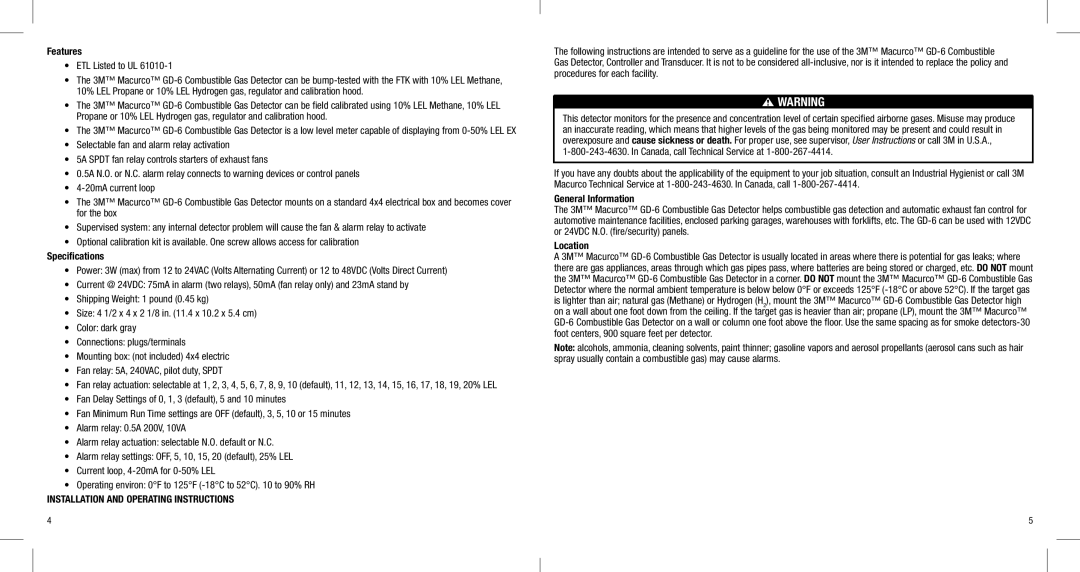
Features
•ETL Listed to UL 61010-1
•The 3M™ Macurco™
•The 3M™ Macurco™
•The 3M™ Macurco™
•Selectable fan and alarm relay activation
•5A SPDT fan relay controls starters of exhaust fans
•0.5A N.O. or N.C. alarm relay connects to warning devices or control panels
•
•The 3M™ Macurco™
•Supervised system: any internal detector problem will cause the fan & alarm relay to activate
•Optional calibration kit is available. One screw allows access for calibration
Specifications
•Power: 3W (max) from 12 to 24VAC (Volts Alternating Current) or 12 to 48VDC (Volts Direct Current)
•Current @ 24VDC: 75mA in alarm (two relays), 50mA (fan relay only) and 23mA stand by
•Shipping Weight: 1 pound (0.45 kg)
•Size: 4 1/2 x 4 x 2 1/8 in. (11.4 x 10.2 x 5.4 cm)
•Color: dark gray
•Connections: plugs/terminals
•Mounting box: (not included) 4x4 electric
•Fan relay: 5A, 240VAC, pilot duty, SPDT
•Fan relay actuation: selectable at 1, 2, 3, 4, 5, 6, 7, 8, 9, 10 (default), 11, 12, 13, 14, 15, 16, 17, 18, 19, 20% LEL
•Fan Delay Settings of 0, 1, 3 (default), 5 and 10 minutes
•Fan Minimum Run Time settings are OFF (default), 3, 5, 10 or 15 minutes
•Alarm relay: 0.5A 200V, 10VA
•Alarm relay actuation: selectable N.O. default or N.C.
•Alarm relay settings: OFF, 5, 10, 15, 20 (default), 25% LEL
•Current loop,
•Operating environ: 0°F to 125°F
INSTALLATION AND OPERATING INSTRUCTIONS
The following instructions are intended to serve as a guideline for the use of the 3M™ Macurco™
WWARNING
This detector monitors for the presence and concentration level of certain specified airborne gases. Misuse may produce an inaccurate reading, which means that higher levels of the gas being monitored may be present and could result in overexposure and cause sickness or death. For proper use, see supervisor, User Instructions or call 3M in U.S.A.,
If you have any doubts about the applicability of the equipment to your job situation, consult an Industrial Hygienist or call 3M Macurco Technical Service at
General Information
The 3M™ Macurco™
Location
A 3M™ Macurco™
Note: alcohols, ammonia, cleaning solvents, paint thinner; gasoline vapors and aerosol propellants (aerosol cans such as hair spray usually contain a combustible gas) may cause alarms.
4 | 5 |
